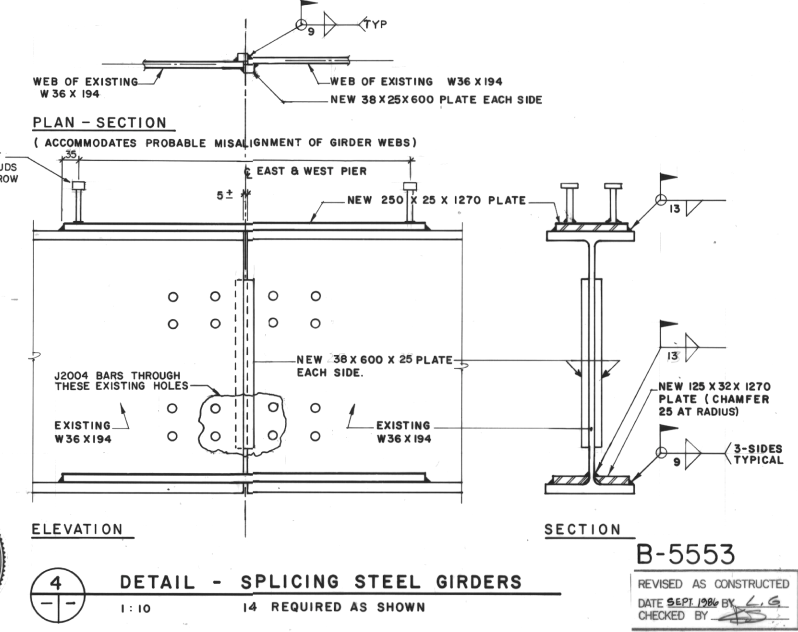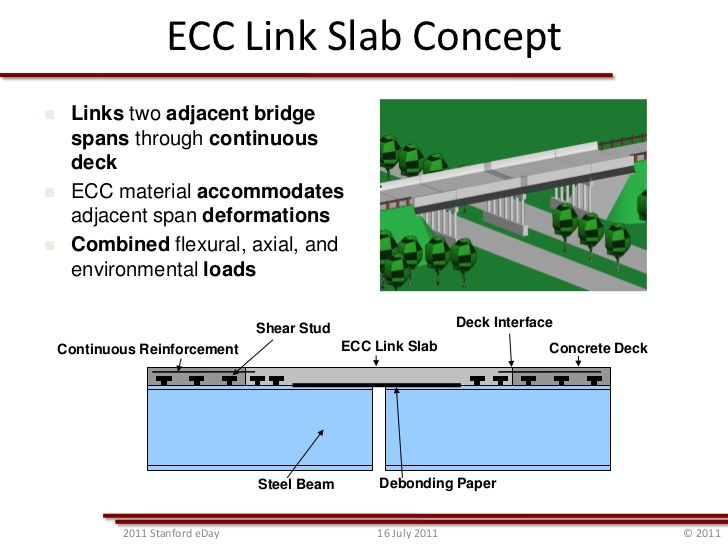damorim
Structural
- Jun 8, 2016
- 63
Hi all,
Working on a major rehab for a structure constructed in 1952 (simply supported steel girders, non-composite CIP deck). The girders were made continuous for live load in 1984 with the use of this detail... Plates were welded onto top of top flange, webs, and top of bottom flange, reinforcement was inserted transversely from girder to girder through the webs, and a concrete diaphragm was cast.

Upon completing a detailed condition assessment and load rating for the structure, we identified this 1984 splice detail as a fatigue-prone detail (especially the transverse welds at the ends of the plates). Theoretical calcs suggest the fatigue-life of the detail has already been exceeded. Tasked with identifying appropriate action and designing detail for major rehab.
Options as I see them:
-Do nothing as visually the detail does not appear to have any problems (can confirm there are no microcracks using mag-particle). However, since fatigue life has been exceeded, who is to know if and when a crack does develop??
-Replace the detail with a similar detail but use all bolted connections. The bottom flange splice will likely need to be extended to allow for a portion without any bolts to accommodate the bearing.
-Revert the girders to simply-supported and provide a "link-slab" to eliminate the need for a joint. There are structural concerns with this given that the continuity was originally instigated to increase the load carrying capacity and to keep up with truck GVW increases of that era. Load rating will need to be rerun assuming the girders are not reverted to simple spans.
What do you guys think? Ever seen something like this? Concerns, suggestions?
Working on a major rehab for a structure constructed in 1952 (simply supported steel girders, non-composite CIP deck). The girders were made continuous for live load in 1984 with the use of this detail... Plates were welded onto top of top flange, webs, and top of bottom flange, reinforcement was inserted transversely from girder to girder through the webs, and a concrete diaphragm was cast.

Upon completing a detailed condition assessment and load rating for the structure, we identified this 1984 splice detail as a fatigue-prone detail (especially the transverse welds at the ends of the plates). Theoretical calcs suggest the fatigue-life of the detail has already been exceeded. Tasked with identifying appropriate action and designing detail for major rehab.
Options as I see them:
-Do nothing as visually the detail does not appear to have any problems (can confirm there are no microcracks using mag-particle). However, since fatigue life has been exceeded, who is to know if and when a crack does develop??
-Replace the detail with a similar detail but use all bolted connections. The bottom flange splice will likely need to be extended to allow for a portion without any bolts to accommodate the bearing.
-Revert the girders to simply-supported and provide a "link-slab" to eliminate the need for a joint. There are structural concerns with this given that the continuity was originally instigated to increase the load carrying capacity and to keep up with truck GVW increases of that era. Load rating will need to be rerun assuming the girders are not reverted to simple spans.
What do you guys think? Ever seen something like this? Concerns, suggestions?


